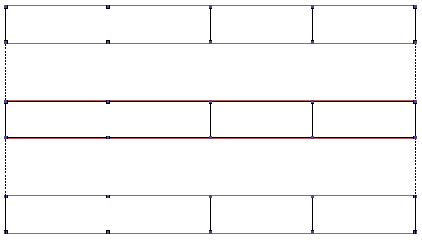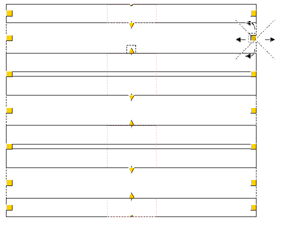

Using the standardized racks on the Industrial Racks tab, it is easy to plan large warehouses. All of the components on this tab can be modified extensively.
On the tab there are three types of rack: Pallet Rack, Cable Rack and Cantilever Rack. The three types have settings for Section Length and Height. For the Pallet Rack group, you can also pre-set Beam Distance and Number of Levels.
On the Industrial Racks tab you will find a similar set of components as on the Industrial Shelving tab. Here you also use templates.
You can pre-set values separately for each group on the tab. Below, the settings are however described from a general point of view. The example is based on the first group, Pallet Racks.
In the Section Length text box you can specify the length of the Bay section.
In the Height text box, you can specify the height of the Bay section.
Using Beam Distance you can determine whether the individual beams should be distributed evenly across the vertical space or whether they should be a specific distance apart.
Using Number of Levels you can determine how many levels there should be for each frame. Using the Fill button, you can fill the frame with beams which are separated by the distance you specified in Beam Distance. Click on the arrow button to enter the desired number.
You use the same method when working with all three groups on the Industrial Racks tab. Below, this method is described from a general point of view. The example is based on the first group, Pallet Rack.
The two first components, Single template and Double template are, as their name suggests, templates used for planning larger systems. The Single template creates single rows of racks, whereas the Double template creates double rows. First you create a layout of the racks using the templates. Thereafter you fill the template layout with the bays, using the Bay section component.
To put out one or a few individual bays, it is not necessary to use the templates.
Follow the instructions below:
Enter settings for Section Length, Height, Beam Distance and Number of Levels.
Select the Bay section component and position it in the drawing area. Continue clicking for extra components.
In order to build a row of bays, it is recommended that you first use a template. Place it in the drawing area and fill it with as many bay sections as will fit in it.
To do this, follow the instructions below:
Enter settings for Section Length, Height, Beam Distance and Number of Levels.
Place a Single template or a Double template in the drawing area.
Stretch the template to make it longer. You can do this when you position the template or afterwards. However, to be able to do this, the component must be activated.
Select the Bay section component and put it opposite the Single template or the Double template. The Bay section will snap inside the contour line of the extended template.
After you have positioned the first section, continue clicking to fill the template with as many bays as you want.
|
Note:
|
The components Aisle and Auto at the bottom of the tab can be used together with all three groups on the tab. The Aisle component snaps to the Single template and the Double template and creates aisles between rows of racks.
You only have to place one aisle place in the drawing and define the width of that one Then, as you continue placing new template rows, new aisles will appear automatically. These will receive the same width as the initial one.
The Aisle component cannot be used on its own.
Example 1:
You want to create three rows of pallet racks in a warehouse. Each of the rows is to be 11 meters long. There is to be a aisle 1.5 meters wide between the rows.
To do this, follow the instructions below:
Select the Single template from the Pallet Rack group and position it in the drawing area.
Stretch the template until it is 11 meters long.
From the bottom of the tab, fetch the Aisle component and move it towards the middle of the row of pallet racks.
Click the Aisle in position. It appears as an area surrounded by a dashed line.
Make sure that the Aisle is activated (its yellow snap points are visible), click on one of the snap points on the long side of the aisle and stretch it until the input display shows a Width of 1,500 mm.
Select a new Single template from the Pallet Rack group and position it opposite the long dashed line.
When the template snaps, click it in position.
Move the mouse pointer a little bit downwards in the drawing area. Now, the mouse pointer has a new Single template attached to it. The aisle width, 1.5 meter, is automatically included. Click the third template row in position.
Select the Auto component, move it towards one of the middle sections of the template and click it in position. Now, the whole template will be filled with as many pallet-rack sections as can be fitted in (see Figure 1).

Figure 1 shows the racks when they are complete.
|
Note:
|

Figure 2 illustrates how the width of a whole template can be stretched in the drawing area.
Example 2:
You want to position two rows of Cantilever Rack (Figure 3) in a building. Each row is to be approximately 6.5 meters long. There is to be an aisle of 1.5 meters between the rows.
To do this, follow the instructions below:
Select the Single template from the Cantilever Rack group and position it in the drawing area.
Stretch the component until it is approximately 6,500 mm long.
Select the Aisle component and move it towards the middle of the row of racks.
Click the Aisle in position. It appears as an area surrounded by a dashed line.
Make sure that the Aisle is activated (its yellow snap points are visible), click on one of the snap points on the long side of the aisle and stretch it until the input display shows a width of 1,500 mm.
Select a new Single template from the Cantilever Rack group and move it towards the long dashed line. When the component snaps, click it in position. Drag the mouse pointer outside the drawing area to drop the new component that appears automatically.
Select the Auto component, move it towards one of the middle sections of the empty template and click it in position. Now you have filled the whole template with as many sections as can be fitted in.

Figure 3